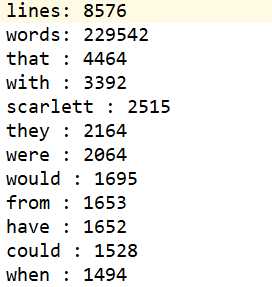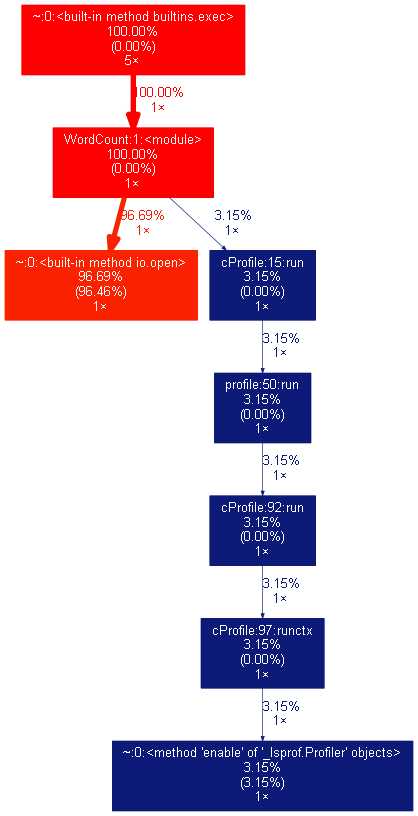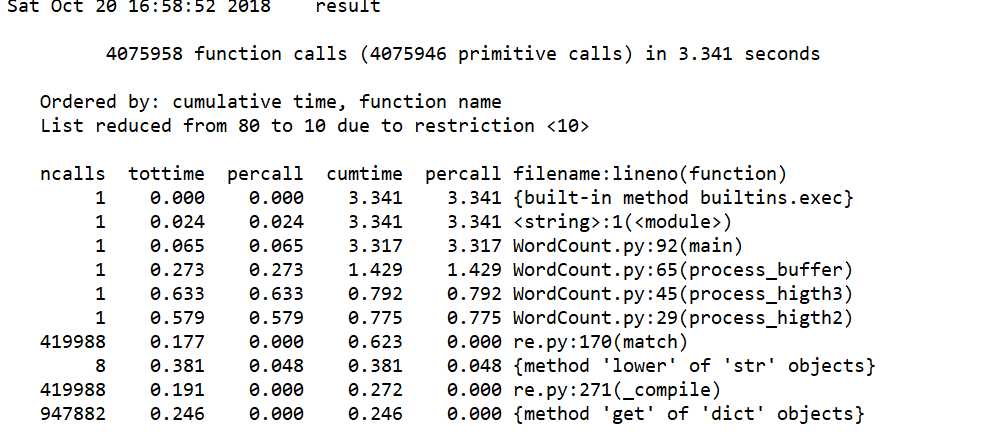軟工作業4:詞頻統計 ——基本功能
一、基本信息
1、編譯環境:Pycharm2018、Python3.8
2、作者:1613072007 周磊
1613072008 俞林森
3、項目地址:https://gitee.com/ntucs/PairProg.git
二、項目分析
1.1、讀文件到緩沖區 process_file(dst,f)
def process_file(dst, f): # 讀文件到緩沖區 try: # 打開文件 doc = open(dst, ‘r‘) except IOError as s: print(s) return Nonetry: # 讀文件到緩沖區 bvffer = doc.read() except: print("Read File Error!") return None doc.close() return bvffer
1.2、統計行數 process_line(dst, f)
def process_line(dst, f): #統計行數 count = 0 for line in open(dst, ‘r‘).readlines(): if line != ‘‘ and line != ‘\n‘: count += 1 print(‘lines:‘, count, file=f)
1.3、統計單詞 process_line(dst, f)
def process_buffer(bvffer, f): if bvffer: word_freq = {} # 下面添加處理緩沖區 bvffer代碼,統計每個單詞的頻率,存放在字典word_freq for ch in ‘“‘!;,.?”‘: # 將文本內容都改為小寫且除去文本中的中英文標點符號 bvffer = bvffer.lower().replace(ch, "") bvffer = bvffer.strip().split() # strip()刪除空白符;split()以空格分割字符串 regex = "^[a-z]{4}(\w)*" words = [] for word in bvffer: # 判定是否是符合單詞設定 if re.match(regex, word): words.append(word) print(‘words:‘, len(words), file=f) # 輸出單詞總數 for word in words: # 獲取字典 word_freq[word] = word_freq.get(word, 0) + 1 for key in list(word_freq): # 刪除一些常用單詞 if key in st1: del word_freq[key] return word_freq
1.4、統計兩個單詞的詞組 process_higth2(bvffer, f)
def process_higth2(bvffer, f): #統計兩個單詞詞組 Phrase = [] Phrase_freq = {} words = bvffer.strip().split()#單詞分割 for y in range(len(words) - 1): if words[y][-1] in ‘’“‘!;,.?”‘ or words[y + 1][0] in ‘’“‘!;,.?”‘: # 判斷兩個單詞之間是否有其他符號 continue elif words[y][0] in ‘’“‘!;,.?”‘: # 判斷第一個單詞前是否有符號 words[y] = words[y][1:] elif words[y + 1][-1] in ‘’“‘!;,.?”‘: # 判斷第二個單詞後是否有符號 words[y + 1] = words[y + 1][:len(words[y + 1]) - 1] Phrase.append(words[y] + ‘ ‘ + words[y + 1]) # 錄入列表Phrase for ph in Phrase: Phrase_freq[ph] = Phrase_freq.get(ph, 0) + 1 # 生成詞組字典 return Phrase_freq
1.5、統計三個單詞的詞組 process_higth3(bvffer, f)
def process_higth3(bvffer, f):#統計三個單詞詞組 Phrase = [] Phrase_freq1 = {} words = bvffer.strip().split() # 單詞分割 for y in range(len(words) - 2): if words[y][-1] in ‘’“‘!;,.?”‘ or words[y + 1][0] in ‘’“‘!;,.?”‘: continue elif words[y + 1][-1] in ‘’“‘!;,.?”‘ or words[y + 2][0] in ‘’“‘!;,.?”‘: continue elif words[y][0] in ‘’“‘!;,.?”‘: words[y] = words[y][1:] elif words[y + 1][-1] in ‘’“‘!;,.?”‘: words[y + 2] = words[y + 2][:len(words[y + 2]) - 1] Phrase.append(words[y] + ‘ ‘ + words[y + 1] + ‘ ‘ + words[y + 2]) # 錄入列表Phrase for ph in Phrase: Phrase_freq1[ph] = Phrase_freq1.get(ph, 0) + 1 # 生成詞組字典 return Phrase_freq1
1.6、輸出單詞 output_result(word_freq, f)
def output_result(word_freq, f):#輸出單詞 if word_freq: sorted_word_freq = sorted(word_freq.items(), key=lambda v: v[1], reverse=True) for item in sorted_word_freq[:10]: # 輸出 Top 10 的單詞 print(item[0], ‘:‘, item[1], file=f)
1.7、主函數 main()
def main(): dst = "Gone_with_the_wind.txt" # A_Tale_of_Two_Cities Gone_with_the_wind f = open(‘result.txt‘, ‘w‘) # 寫入結果路徑 process_line(dst, f) bvffer = process_file(dst, f) # 讀文件到緩沖區 word_freq = process_buffer(bvffer, f) # 生成單詞字典 Phrase_freq2 = process_higth2(bvffer, f) # 生成詞組字典 Phrase_freq3 = process_higth3(bvffer, f) # 生成詞組字典 output_result(word_freq, f) # 輸出單詞前10 print(‘雙詞組前十詞組:‘, file=f) output_result(Phrase_freq2, f) # 輸出雙詞組前10 print(‘三詞組前十詞組:‘, file=f) output_result(Phrase_freq3, f) # 輸出雙詞組前10
1.8、性能測試
if __name__ == "__main__": cProfile.run("main()",filename="result") p=pstats.Stats("result") p.strip_dirs().sort_stats("calls").print_stats(10) p.strip_dirs().sort_stats("cumulative", "name").print_stats(10)
2.1、時間復雜度和空間復雜度
時間復雜度和空間復雜度的計算以下面這段代碼為例
def process_higth2(bvffer, f): #統計兩個單詞詞組 Phrase = [] Phrase_freq = {} words = bvffer.strip().split()#單詞分割 for y in range(len(words) - 1): if words[y][-1] in ‘’“‘!;,.?”‘ or words[y + 1][0] in ‘’“‘!;,.?”‘: # 判斷兩個單詞之間是否有其他符號 continue elif words[y][0] in ‘’“‘!;,.?”‘: # 判斷第一個單詞前是否有符號 words[y] = words[y][1:] elif words[y + 1][-1] in ‘’“‘!;,.?”‘: # 判斷第二個單詞後是否有符號 words[y + 1] = words[y + 1][:len(words[y + 1]) - 1] Phrase.append(words[y] + ‘ ‘ + words[y + 1]) # 錄入列表Phrase for ph in Phrase: Phrase_freq[ph] = Phrase_freq.get(ph, 0) + 1 # 生成詞組字典 return Phrase_freq
因為兩個for循環不是嵌套的,因此時間復雜度為O(n)。時間復雜度為O(1)。
3.1、程序運行案例截圖


停詞表:

三、性能分析
我們大概花了一個多小時在提高程序性能上,原本運行時間是10秒second,經過代碼改進後運行時間提升至3.341second。
主要修改代碼如下:
def process_buffer(bvffer, f): if bvffer: word_freq = {} # 下面添加處理緩沖區 bvffer代碼,統計每個單詞的頻率,存放在字典word_freq for ch in ‘“‘!;,.?”‘: # 將文本內容都改為小寫且除去文本中的中英文標點符號 bvffer = bvffer.lower().replace(ch, " ") words = bvffer.strip().split() # strip()刪除空白符;split()以空格分割字符串 for word in words: # 判定是否是符合單詞設定 y = 1 s = True for x in word: if y > 4: break if (x < ‘a‘ or x > ‘z‘) and x not in ‘’‘: s = False break y = y + 1 if s == False: words.remove(word) print(‘words:‘, len(words), file=f) # 輸出單詞總數 for word in words: # 獲取字典 word_freq[word] = word_freq.get(word, 0) + 1 for key in list(word_freq): # 刪除一些常用單詞 if key in stop_wred: del word_freq[key] return word_freq
改為:
st = open("stop_word.txt", ‘r‘)
st1 = st.read()
def process_buffer(bvffer, f): if bvffer: word_freq = {} # 下面添加處理緩沖區 bvffer代碼,統計每個單詞的頻率,存放在字典word_freq for ch in ‘“‘!;,.?”‘: # 將文本內容都改為小寫且除去文本中的中英文標點符號 bvffer = bvffer.lower().replace(ch, " ") bvffer = bvffer.strip().split() # strip()刪除空白符;split()以空格分割字符串 regex = "^[a-z]{4}(\w)*" words = [] for word in bvffer: # 判定是否是符合單詞設定 if re.match(regex, word): words.append(word) print(‘words:‘, len(words), file=f) # 輸出單詞總數 for word in words: # 獲取字典 word_freq[word] = word_freq.get(word, 0) + 1 for key in list(word_freq): # 刪除一些常用單詞 if key in st1: del word_freq[key] return word_freq
(1)按執行次數


(2)按執行時間


四、其他
1、結對編程時間開銷(單位:小時)
這次結對編程大概用了8個多小時,因為不精通python,很多內容沒接觸過,所以做的時候就基本是邊學邊寫的。
2、結對編程照片

五、事後分析與總結
1、 簡述結對編程時,針對某個問題的討論決策過程
一開始使用的停詞表是直接寫在py文件中的,但是考慮到效率問題,最終采用txt來讀取停詞表,來實現刪除不想要的單詞。
2、評價
(1)周磊對俞林森的評價:個人能力強,不遺余力參與到合作編程中,與他討論的時候能夠給我很大的啟發,並且會提出代碼中不足的地方,希望能與他再次合作!
(2)俞林森對周磊的評價:周磊同學對python有過接觸,而我基本就是個小白,此次他編寫了大部分內容,我做到盡量不拖後腿。
3、關於結對過程的建議
結對編程的過程收獲頗多,我覺得結對編程有好有壞,但是好處遠遠大於的不好的地方。兩個人難免會遇到意見不同的時候,關鍵是看此時如何協調、如何溝通、如何采納。如果團隊內部不能很好地處理這些分歧,那麽非但不能提高效率,反而會拖慢工作的進程。如果團隊協調得很好,那麽兩個人的力量是絕對大過一個人的。一個人的想法始終有限,兩個人或者一群人合作,說不定還能擦出思想的火花。
4 、其它:
希望下次能接觸到其它語言的題目。
軟工作業4:詞頻統計 ——基本功能
